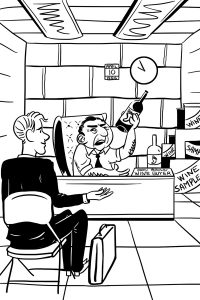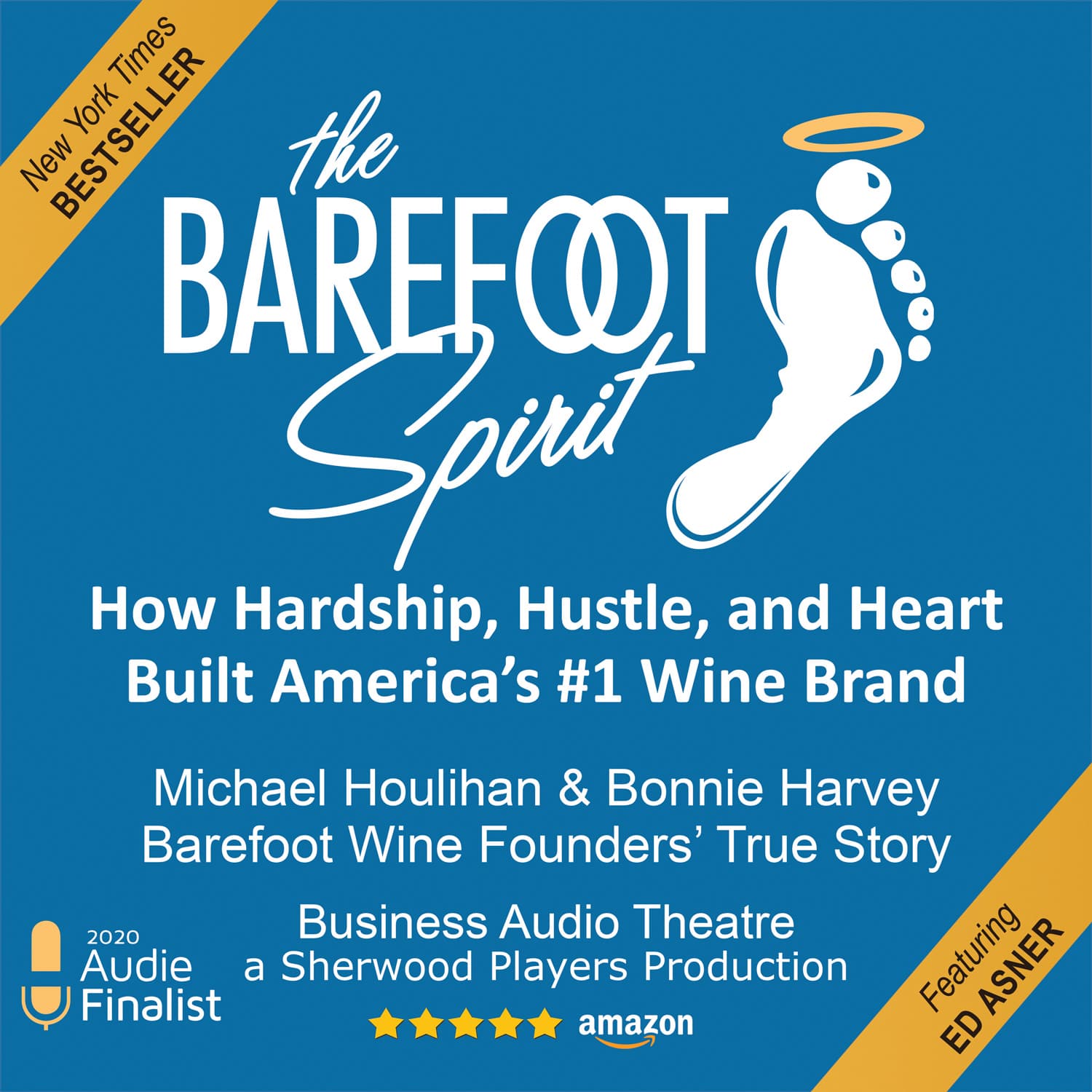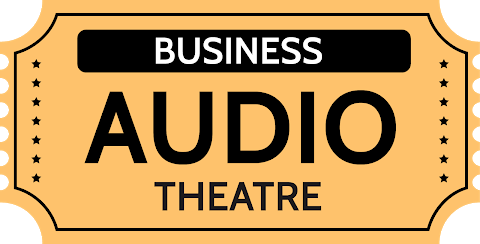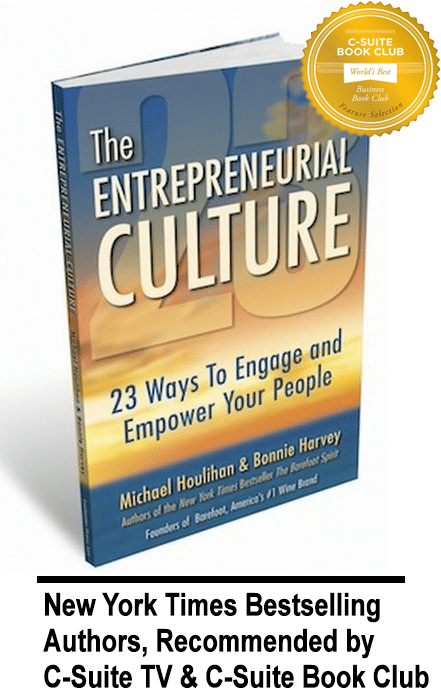
The most common question we get is, “What was the biggest challenge you faced in producing Business Audio Theater?” When we wrote our original paperback, The Barefoot Spirit – How Hardship, Hustle, and Heart Built America’s #1 Wine Brand, our manuscript was over 8 inches thick. Like most authors, we wanted to get everything we could think of into that book. But we realized we had to get it down to one airplane ride, about 5/8 of an inch, or 200 pages.
We asked our author, Rick Kushman, how he was going to get that huge manuscript down to the size that someone would actually read. He got a smile on his face and told us the story of the sculpture who was charged with creating the image of the King from a solid block of marble. When asked how he was going to accomplish this, he said, “I’ll just chip away everything that doesn’t look like the King!”
So, the “King” was the prominent message we wanted our book to convey, and everything else that didn’t “look like the king” was chipped away! What was our predominate message? Overcoming adversity! And doing it by the application of business principles we collectively refer to as “The Barefoot Spirit.”
Meanwhile, back at the business audio theater, we faced a similar challenge. Audio theatre is scene after scene with actors, scripts, dialogue, action, outcome, and takeaways. We added sound effects and music to embellish the action and add to the entertainment value, but it is still all about scenes.
In business audio theatre, the scenes must demonstrate business principles. So, what did the “King” look like? True, reenacted scenes from our business journey that dramatize one or more of the guiding principles we employed to be successful. That’s the “King.” Scenes over simple narration.
Nowhere in The Barefoot Spirit audiobook is that underlying tenet more exemplified than in chapter 3, Taking on the Behemoth. Here, scene after scene demonstrates timeless business lessons entrepreneurs and wantrepreneurs need to witness to help them overcome popularly held misconceptions. Basically, “Don’t tell me, show me!” In each scene the proponents (us) have their preconceived notions blown apart by the reality of the marketplace.
The title, Taking on the Behemoth, describes what happens when novices attempt to mount the mastodon and then try to casually ride it back to the cave. The learning curve is steep. The lessons are hard learned …and painful!
First, they try to take on production and manage a bottling machine with thousands of moving parts, with labels, corks, closures, and glass going into one end and bottled wine coming out of the other. It’s big, noisy, and foreign, and the humans on the job are imperfect. Mistakes are made at the producer’s expense. It’s not just how you manage it, it also how you manage the people you are depending on to run the dang thing.
Second, the whole experience raises much bigger issues effecting most businesses, like why outsource? And if you do, how much and what kind of control do you need to exhibit to ensure quality control? The proponents wrestle with this and are told by the industry that they will follow “standard winemaking procedures” when doing work for them. But when asked for a copy, none can be produced. The proponents have to write their own. They engage experts and finally come up with the parameters, standards, and metrics that are the backbone of their outsourced bottling contracts.
Today, they tell their audiences, “When we started Barefoot, our contracts were only 3 pages long. When we sold it, they were 37 pages long!” That’s how many times they were taken advantage of because they weren’t clear enough or didn’t specify something in greater detail.
They tell their clients who are starting their own businesses to outsource everything they can except sales, accounting, and quality control. They point out how it was both a challenge and a godsend, because once they mastered the contracts and oversight, they significantly reduced their overhead (a cost that went on whether or not they made sales!).
The key to improving a contract is to always ask, “Now, how can we prevent that mistake from happening again?” In other words, add a new clause to the contract. See how their contracts grew so fast?
When you are cast headlong into an industry (or even a part of an industry you must navigate to succeed) you must be humble enough to ask questions, tons of questions. And not just from the higher ups but people at all levels in that industry. Then you must comply with their advice and be grateful you got it.
Such was the case with Michael and Bonnie. They asked and asked. And they got great answers with commonsense insights. They got advice they would have never asked for or gotten had they been experienced in the industry.
Finally they were in the marketplace with their product. They were so excited! They had the answer everyone was looking for – low price, high quality, cute label, right package-market fit. Hey, what’s not to like?! Or so they thought. Like most entrepreneurs, they fell in love with their product. Oops! One mistake:
They did not fully comprehend the fact that the supermarkets and big box stores want to “milk the cow, and nobody wants to raise the calf!” In other words, the brand “Barefoot” was unknown and had no budget for advertising. Even though the big buyer was given exactly what he said was needed, he did not put Barefoot in his stores. But in the process, he showed them what had to be done. Barefoot had to become a household word before the big buyer (or any other big buyer) would take it! So much for Plan A!
When we are young, we get the idea that our heroes have to behave elegantly and somewhat polished, certainly not rude and snarky. But in this case, the big buyer was the imperfect Buddha. True wisdom was wrapped in a tough and prickly persona of sarcasm and impatience. But it was true wisdom. And they followed the advice. In this scene the powerful supermarket buyer is authoritatively played by the legendary Hollywood actor, Ed Asner.
Along with learning lessons at an ever increasing clip, came the realization that they couldn’t afford the advertising required to make the public aware of the brand. If necessity is the mother of invention, being undercapitalized is surely the father. Your eyes and ears are opened to anything you can used to get the job done.
Solutions can come from left field disguised and subtle, easy to ignore. But if you are looking for anything you can use, you won’t miss an opportunity. They solve the problem and make “Barefoot” a household word by supporting groups that aligned with their passion for conservation and human rights.
But even with all this, most of the jobs required they have to do personally. A variety of jobs had to be done, requiring a wide range of knowledge they did not yet have. It wasn’t the jobs they signed up for. And no one would do it but them! No one cared about their product and success like they did. And, if the jobs were not done and done right, it would drastically affect their sales. The question was, as it is in all businesses, were they willing to do the work? That is the real work necessary to take on the Behemoth!
Please enjoy Chapter 1 as our guest and see if you want to join us for the adventure!
Who We Are

Michael Houlihan and Bonnie Harvey co-authored the New York Times bestselling business book, The Barefoot Spirit: How Hardship, Hustle, and Heart Built America’s #1 Wine Brand. The book has been selected as recommended reading in the CEO Library for CEO Forum, the C-Suite Book Club, and numerous university classes on business and entrepreneurship. It chronicles their humble beginnings from the laundry room of a rented Sonoma County farmhouse to the board room of E&J Gallo, who ultimately acquired their brand and engaged them as brand consultants. Barefoot is now the world’s largest wine brand.
Beginning with virtually no money and no wine industry experience, they employed innovative ideas to overcome obstacles, create new markets and forge strategic alliances. They pioneered Worthy Cause Marketing and performance-based compensation. They built an internationally bestselling brand and received their industry’s “Hot Brand” award for several consecutive years.
They offer their Guiding Principles for Success (GPS) to help entrepreneurs become successful. Their book, The Entrepreneurial Culture: 23 Ways To Engage and Empower Your People, helps corporations maximize the value of their human resources.
Currently they travel the world leading workshops, trainings, & keynoting at business schools, corporations, conferences. They are regular media guests and contributors to international publications and professional journals. They are C-Suite Network Advisors & Contributing Editors. Visit their popular brand building site at www.consumerbrandbuilders.com.
To make inquiries for keynote speaking, trainings or consulting, please contact sales@thebarefootspirit.com.






